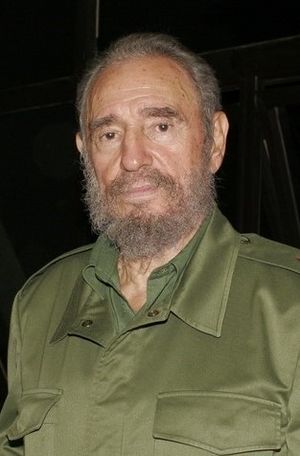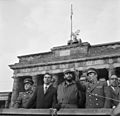Fidel Castro facts for kids
Quick facts for kids
Fidel Castro
|
|
|---|---|
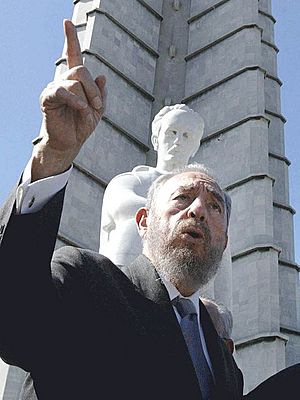
Castro in front of a Havana statue of Cuban national hero José Martí in 2003
|
|
| President of Cuba | |
| In office December 2, 1976 – February 24, 2008 |
|
| Preceded by | Osvaldo Dorticós Torrado |
| Succeeded by | Raúl Castro |
| First Secretary of the Communist Party of Cuba | |
| In office July 1961 – 19 April 2011 |
|
| Personal details | |
| Born |
Fidel Alejandro Castro Ruz
August 13, 1926 Birán, Cuba |
| Died | November 25, 2016 (aged 90) Havana, Cuba |
| Spouses | Mirta Diaz-Balart (m. 1948-1955) Dalia Soto del Valle (m. 1980-2016) |
| Relations | Ángel Castro y Argiz (father) Ramón Castro Ruz (brother) Raúl Castro (brother) Juanita Castro (sister) |
| Children | 9, including Alina Fernández |
Fidel Alejandro Castro Ruz (August 13, 1926 – November 25, 2016) was a very important leader in Cuba for almost 50 years. He was a revolutionary and politician. He served as Prime Minister of Cuba from 1959 to 1976. Later, he became President from 1976 to 2008.
In 2006, he temporarily gave power to his brother Raúl Castro because he was recovering from surgery. On February 19, 2008, he announced that he would not return to power. He was in charge of Cuba for 49 years.
Contents
Early Life and Education
Fidel Alejandro Castro Ruz was born in Birán, Cuba on August 13, 1926. When he was six, Castro went to live with his teacher. He was baptized into the Roman Catholic Church at age eight. This allowed him to attend the La Salle boarding school. He often misbehaved there. After that, he went to the Jesuit-run Dolores School in Santiago.
In 1942, Castro moved to another Jesuit school, El Colegio de Belén in Havana. He enjoyed history, geography, and debating. However, he spent most of his time playing sports instead of focusing on schoolwork.
Political Career and Revolution
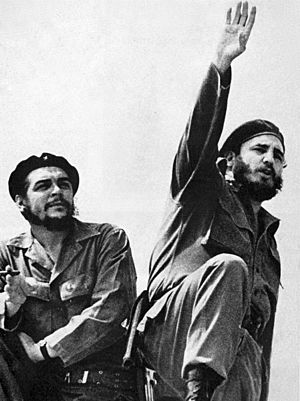
While studying law at the University of Havana, Castro became interested in leftist ideas. These ideas focused on fairness and opposing powerful countries controlling others. He took part in rebellions against governments in the Dominican Republic and Colombia.
Later, he planned to overthrow the Cuban president, Fulgencio Batista. In 1953, he led a failed attack on the Moncada Barracks. After being imprisoned for a year, Castro went to Mexico. There, he formed a revolutionary group called the 26th of July Movement. His brother Raúl Castro and Ernesto "Che" Guevara joined him.
They returned to Cuba and led a guerrilla war against Batista's forces. This fight took place from the Sierra Maestra mountains. After Batista was overthrown in 1959, Castro became Cuba's prime minister. He took control of both the military and the government.
Leading Cuba: Social Changes
Castro's government focused on improving the lives of Cubans. They started many social projects. These projects often came before economic growth. Education was very important to Castro. In his first 30 months, more classrooms opened than in the previous 30 years.
The primary education system in Cuba included a work-study program. Students spent half their time in class and half doing productive activities. Healthcare was also changed. It became free and available to everyone. New health centers opened across the island. Vaccinations for childhood diseases became common. This greatly reduced the number of babies who died.
The government also worked on improving roads and water systems. They built many new houses to help with homelessness. Nurseries and day-care centers opened for children. Other centers helped people with disabilities and the elderly.
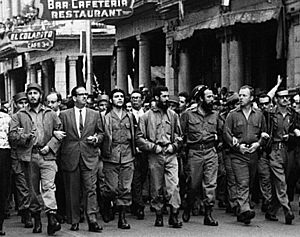
Castro used radio and television to talk directly with the people. He would ask questions and make strong statements. Many workers, farmers, and students supported him. However, some middle-class people did not agree with his government. Thousands of doctors and engineers moved to the US. This caused a "brain drain," meaning Cuba lost many skilled people.
Newspapers that criticized the government faced problems. In January 1960, the government made them publish a "clarification" written by the printers' union. Castro's government also arrested hundreds of people they called "counter-revolutionaries." These were people who opposed the revolution. Some faced harsh treatment. Groups against Castro, supported by people who had left Cuba and the US, started armed attacks. This led to a six-year fight called the Escambray Rebellion.
Cold War and International Relations
In 1960, the Cold War was happening. This was a time of tension between the United States and the Soviet Union (USSR). The US was a capitalist democracy. The USSR was a socialist state led by the Communist Party. Castro did not like the US. He shared ideas with the USSR.
He made a deal with the USSR. Cuba would give them sugar and other goods. In return, the USSR would send oil, fertilizers, and industrial goods. They also gave Cuba a $100 million loan. Cuba's government told US-controlled oil refineries to process Soviet oil. But the US pressured them to refuse. Castro then took control of these refineries.
The US responded by stopping its import of Cuban sugar. Castro then took control of most US-owned businesses in Cuba, including banks. In January 1961, Castro told the US Embassy in Havana to reduce its staff. He thought many were spies. The US then ended diplomatic relations. They also gave more money to groups of Cubans who opposed Castro. These groups attacked ships and bombed factories.
Both President Eisenhower and President Kennedy supported a plan to help these groups invade Cuba. The goal was to overthrow Castro. This plan led to the Bay of Pigs Invasion in April 1961.
Bay of Pigs Invasion
On April 15, planes supplied by the US bombed three Cuban military airfields. The US claimed Cuban air force pilots were responsible. But Castro showed that these claims were false. Fearing an invasion, he ordered the arrest of many people suspected of being against the revolution.
A group of 1,400 fighters, called Brigade 2506, was based in Nicaragua. On the night of April 16-17, Brigade 2506 landed at Cuba's Bay of Pigs. They fought with a local Cuban militia. Castro personally took control of the counter-attack. After bombing the invaders' ships and bringing in more troops, Castro forced the Brigade to surrender on April 20.
He ordered the captured rebels to be questioned on live television. Castro himself took part in the questioning. Most were sent back to the US in exchange for medicine and food. Castro's victory was a big deal around the world. But it also increased opposition from some middle-class Cubans who had been arrested. Many of them later moved to the US.
After this victory, Castro made Cuba a "Socialist Cuba." He became close with the Soviet Union. He allowed the Soviets to place nuclear weapons in Cuba. This led to the Cuban Missile Crisis in 1962. This was a very tense moment during the Cold War.
Socialist Cuba and Global Influence
Castro continued to call for revolutions around the world. He supported groups fighting for their freedom. Cuba's foreign policy was against powerful countries controlling others. He believed every nation should control its own resources. He allowed revolutionary groups from different countries to train in Cuba. These included groups like the Viet Cong and the Black Panther Party.
He thought Africa was ready for revolution. He sent troops and doctors to help a socialist government in Algeria. He also allied with the socialist government in Congo-Brazzaville. In 1965, Castro allowed Che Guevara to go to Congo-Kinshasa. There, Guevara trained revolutionaries against the Western-backed government. Castro was very sad when Guevara was killed in Bolivia in 1967.
Castro's growing role on the world stage sometimes caused problems with the USSR. He wanted Cuba to be independent. He refused to sign the Treaty on the Non-Proliferation of Nuclear Weapons. He said it was an attempt by the Soviet Union and the US to control other countries.
In 1968, Castro started a "Great Revolutionary Offensive." He closed all remaining private shops and businesses. He said their owners were against the revolution. This led to a lack of goods. People felt less reason to work hard. Also, some people felt that a new elite group had formed. These were people connected to the government. They had better housing and access to luxury goods.
By the 1980s, Cuba's economy was struggling. The price of sugar went down, and the harvest was bad in 1979. For the first time, many young people were unemployed. The government sent some to work in other countries. Cuba's government secretly sold paintings and traded for US electronic goods to get money.
Presidency and Later Years
In 1985, Mikhail Gorbachev became the leader of the Soviet Communist Party. He tried to bring more freedom and economic changes. Gorbachev agreed to US demands to reduce support for Cuba. This made relations between the Soviet Union and Cuba worse. When Gorbachev visited Cuba in 1989, he told Castro that subsidies for Cuba would end.
With the end of good trade from the Soviet bloc, Castro announced that Cuba was entering a "Special Period in Time of Peace." This meant hard times. Gas was greatly reduced. Chinese bicycles replaced cars. Factories that made non-essential things were shut down. Oxen started to replace tractors. People used firewood for cooking. Electricity cuts lasted up to 16 hours a day.
Castro admitted that Cuba faced its worst situation outside of war. He said the country might have to rely on subsistence farming, growing just enough food to survive. By 1992, Cuba's economy had shrunk by over 40%. There were major food shortages and a lack of basic goods. However, many people still supported Castro.
Castro believed Cuba needed changes for socialism to survive in a world with free markets. In October 1991, he said he would step down as head of government. He would be replaced by Carlos Lage, a much younger leader. But Castro would remain head of the Communist Party and military commander. Many older government members were replaced by younger ones.
Several economic changes were proposed and approved by the people. Farmers' markets and small private businesses became legal. US dollars were also allowed to be used as money. Some rules on leaving the country were made easier. This allowed more Cubans to move to the United States.
Final Years and Death
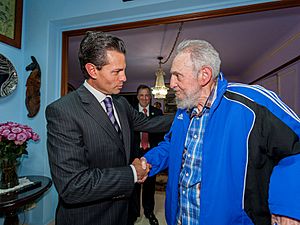
In 2006, Castro had surgery. He handed over his presidential duties to Raúl Castro. On February 24, 2008, the National Assembly of People's Power voted Raúl as president. Raúl said his brother was "not substitutable." He suggested that Fidel still be asked for advice on important matters. All 597 members of the National Assembly agreed.
After he retired, Castro's health got worse. He still talked with the Cuban people. He wrote an opinion column called "Reflections." He also used a Twitter account and gave occasional public talks.
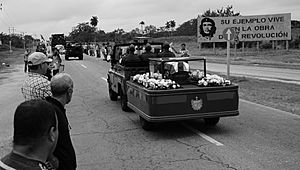
Castro died in Havana on November 25, 2016. The cause of his death was not shared. His body was cremated on November 26, 2016.
Personality and Interests
Castro was known for working very long hours. He usually woke up late, around 10 or 11 AM. He would start working around noon and continue late into the night. He often went to bed at 3 or 4 AM. He liked to meet foreign diplomats in the early morning. He believed they would be tired, giving him an advantage in talks.
Castro enjoyed meeting ordinary citizens. He treated Cubans like they were part of his own big family. A British historian said that Castro was a "patriot." He deeply felt it was his job to save the Cuban people.
Castro was very knowledgeable and had an amazing memory. He could speak for hours on many different topics. His hero was Alexander the Great. Castro was a huge reader. Some of his favorite authors were Ernest Hemingway and William Shakespeare. He loved the book For Whom the Bell Tolls. He even memorized parts of it.
He enjoyed art and photography. He supported both in Cuba. But he was not interested in music or dancing. He loved movies, especially Soviet films. His favorite movie was the five-hour long 1967 film War and Peace.
Castro had a lifelong passion for cows. Starting in 1966, he became very interested in cow genetics and breeding. State media often shared details of his efforts to breed cows that produced more milk. This interest peaked in 1982. A cow he bred, named "Ubre Blanca," broke a Guinness World Record. She produced 29 gallons of milk on live national television. She became a national celebrity. When she died in 1985, the newspaper Granma published an obituary for her. The postal service even issued stamps in her honor.
Public Image
In Cuba, Castro was often called Comandante El Jefe. This means "The Commander in Chief." People usually called him Comandante (The Commander). He was very good at speaking and had a strong presence. He could easily get his audience and even large groups of people to support him.
Castro did not care much about his appearance or clothes. For 37 years, he only wore his famous olive-green military fatigues. For formal events, he wore the standard military uniform. This showed his role as a constant revolutionary. But in the mid-1990s, he started wearing dark civilian suits in public.
He was over 6 feet 3 inches (1.91 m) tall. With his combat boots, he was usually taller than most foreign leaders he met. This gave him a powerful presence in any room or photo. He used this to his advantage.
Personal Life
Castro's first wife was Mirta Díaz-Balart. They married in October 1948. They had a son named Fidel Ángel "Fidelito" Castro Díaz-Balart, born in September 1949. Díaz-Balart and Castro divorced in 1955. In 1980, Castro married Dalia Soto del Valle. Their marriage lasted until Castro's death in 2016.
Images for kids
-
Castro intended to overthrow the presidency of General Fulgencio Batista (left, with U.S. Army Chief of Staff Malin Craig, in 1938).
-
The thickly forested mountain range of the Sierra Maestra, from where Castro and his revolutionaries led guerrilla attacks against Batista's forces for two years. Castro biographer Robert E. Quirk noted that there was "no better place to hide" in all the island.
-
Map showing key locations in the Sierra Maestra during the 1958 stage of the Cuban Revolution
-
Castro (right) with fellow revolutionary Camilo Cienfuegos entering Havana on 8 January 1959
-
CBC/Radio-Canada's journalist and future Premier of Quebec, René Lévesque, interviews Castro during his trip to Montreal in late April 1959.
-
Castro and Indonesian president Sukarno in Havana, 1960. Castro undertook many foreign visits during his initial years in power.
-
Castro at the United Nations General Assembly in 1960
-
Castro and Russian cosmonaut Yuri Gagarin, the first human in space
-
Castro and members of the East German Politburo in Berlin, June 1972
-
Castro meeting with Brazilian president Lula da Silva, a significant "Pink Tide" leader
-
Castro and Camilo Cienfuegos before playing a baseball game
See also
 In Spanish: Fidel Castro para niños
In Spanish: Fidel Castro para niños


